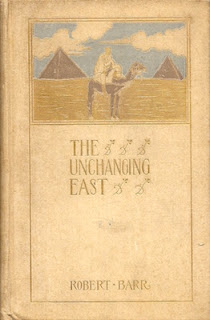An addendum to last week's review of Basil King's The Dust Flower.
Earthbound is one of the greatest motion pictures ever made. Don't take my word – I haven't seen it – consider instead these sentences from the August 5, 1922, edition of the Regina
Leader:
A new photoplay by Basil King, the author of "Earthbound," one of the greatest motion pictures ever made, is coming to the Allen Theater on Monday for three days. It is called "The Dust Flower" and has been made by Goldwyn from the famous writer's new novel of the same name under the direction of Rowand V. Lee.
Earthbound was a sensation in its day. The story of a murdered man who is tormented in the afterlife, it inspired special screenings augmented by sets, musical performances, colour light projections, and elaborate lobby displays.
 |
| Motion Picture News, May 1920 |
In his 1923 essay "Reflections on the Seventh Art," early film theorist Ricciotto Canudo describes
Earthbound as an "astonishing and perfect drama," praising it for combining of "the real and the immaterial, the living and the dead." He had nothing to say about
The Dust Flower.
 |
| The Regina Leader, 5 August 1922 |
Of the eight King novels given the Hollywood treatment,
The Dust Flower is unique in that the author himself adapted the work to the screen. I'm convinced he wrote the novel with the motion picture in mind. How else to explain so simple a story from a writer who was renowned for clever, complex plots. If anything,
The Dust Flower on film is simpler still. Like the novel, it begins with an engagement-ending argument between Rashleigh Allerton (Torontonian James Rennie) and his fiancée Barbara Wallbrook (Mona Kingsley).** Rash storms out, announcing that he'll marry the first woman who will have him. He finds a wife in a young woman named Letty Gravely (Helene Chadwick) whose suicide he prevents.
Poor Letty, her stepfather had been pressuring her to work as a cigarette girl in a sleazy nightclub – apparently, a fate worse than death. Once married to Rash, Letty is coached into becoming a proper lady by Steptoe (Claude Gillingwater), the Allerton family butler. The scene that I liked so much in the novel, in which Letty and Steptoe visit an exclusive dress shop, made it into the film.
While Rash grows to love Letty, she comes to believe her husband is still in love with his former fiancée. Letty returns to her stepfather and accepts the cigarette girl work she so dreaded. Rash tracks her down to the nightclub, and proves his love by punching steppapa.
The Dust Flower is a lost film, which is why I didn't hesitate in giving away the ending; it's nothing like the novel. Tellingly, I think, the greatest difference between
The Dust Flower on paper and on celluloid concerns Letty's life before Rash. An orphan, she'd struggled to support herself and her stepfather by taking on bit parts with various New York motion picture studios. When finances hit rock bottom, Flack robs Letty of what little she owns and throws her out of their tenement flat. Letty doesn't head for the nearest bridge, rather sits on a park bench. She feels liberated, not suicidal.
In September 1923, roughly a year after
The Dust Flower hit the silver screen,
Picture-Play reported that Basil King was "through with movies," adding that the "results of his endeavors for the Goldwyn company – both financial and artistic – were far from satisfactory to him."
Far from satisfactory may be an understatement.
In the novel, Letty would rather a life as a prostitute than a return to studio work.
Trivia: Reviews of
The Dust Flower were extremely positive. The only negative words I've found come in the January 1923 issue of
Screenland. Boy, are they bitchy:
* It's worth noting that in the very same essay Canudo states that the first motion picture of any value is The Miracle Man (1919), based on the novel of the same name by Montrealer Frank L. Packard. I've written about both the book and the movie. Sadly, it's another lost film.
** The surname is 'Walbrook' in the novel.
Related posts:


























